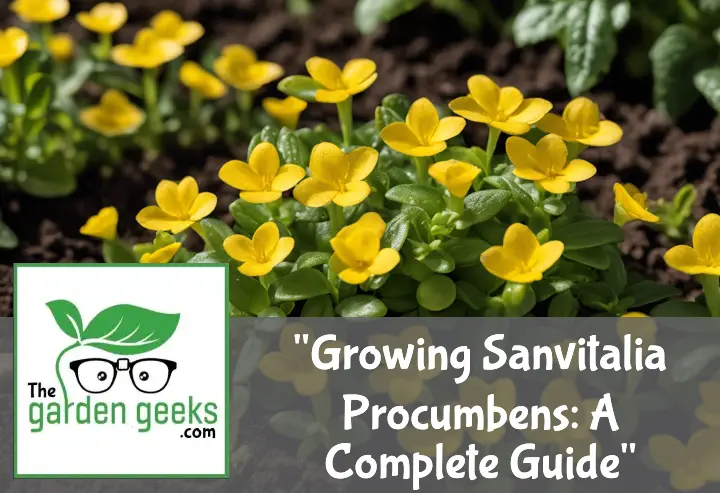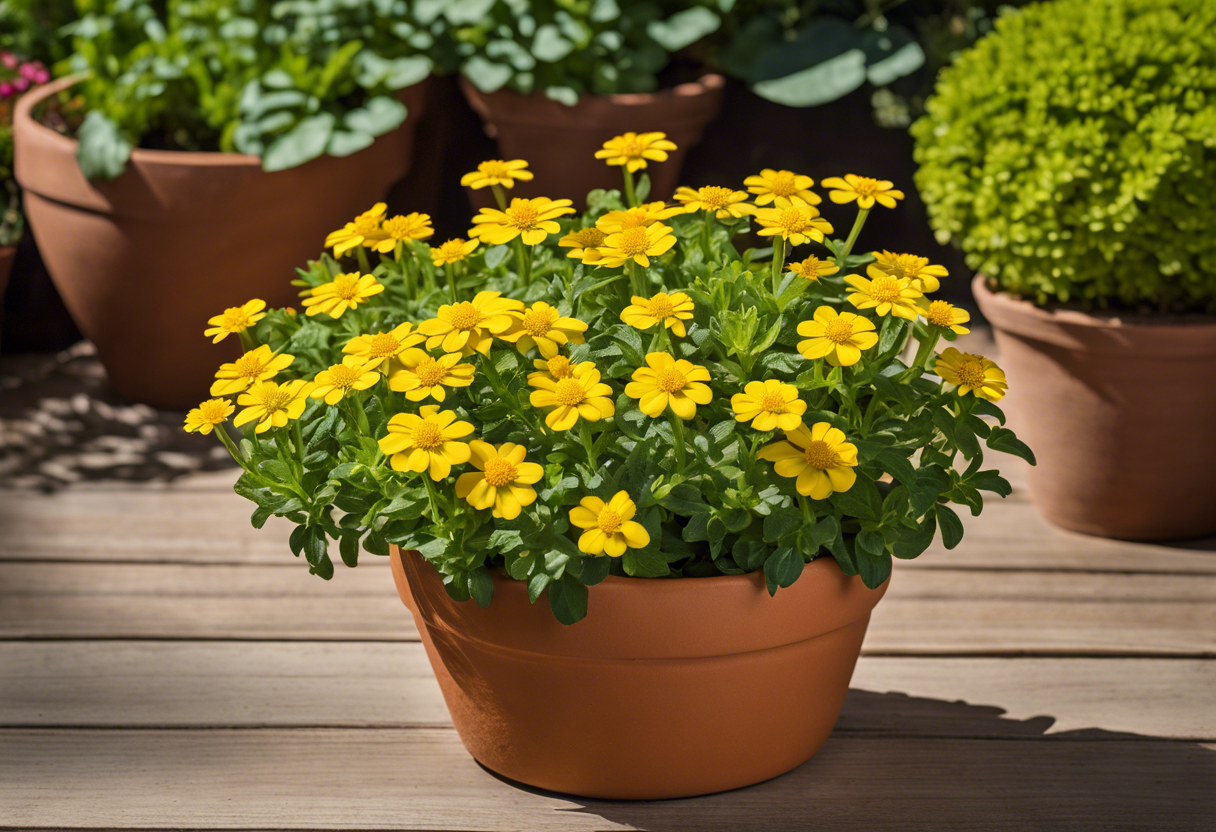Ever stumbled upon a garden and been captivated by the carpet of tiny, sun-like flowers smiling up at you? Well, let me tell you a little secret – those cheery fellas are probably Growing Sanvitalia Procumbens. They’re like sunshine on a stem, I swear!
But don’t be fooled by their cute appearance. Growing these golden nuggets requires more than just a green thumb. It’s like raising a child – rewarding but oh boy, can it test your patience! So buckle up, folks. We’re about to embark on an enlightening journey into the world of Sanvitalia Procumbens. Keep reading about “Growing Sanvitalia Procumbens: A Complete Guide”.
Key Takeaways
- Sanvitalia Procumbens, also known as Creeping Zinnia, is a low-maintenance plant that thrives in full sun and well-drained soil.
- It’s an annual flowering plant that blooms from summer to frost.
- Regular watering is essential but avoid overwatering as it can lead to root rot.
- Fertilize every 4-6 weeks during the growing season for optimal growth.
- Deadhead spent flowers to encourage continuous blooming.
- It’s generally pest-free but watch out for aphids and treat with insecticidal soap if necessary.
What is Sanvitalia Procumbens?
Well, let me tell you. Sanvitalia Procumbens, or as it’s commonly known, the Creeping Zinnia, is a charming little plant that’s sure to add a splash of sunshine to any garden. It’s like the life of the party in plant form!
Origin and Description
The origin of Sanvitalia Procumbens traces back to Mexico. This sun-loving flower has made its way around the globe, spreading joy wherever it goes.
Now, let’s talk about what this beauty looks like. The physical characteristics of Creeping Zinnia are quite distinctive. It’s a low-growing annual with bright yellow flowers that have dark centers – think mini sunflowers! The leaves are green and lance-shaped, adding to its overall appeal.
Varieties of Sanvitalia Procumbens
There are several varieties of Creeping Zinnia out there, each with their own unique features. For example, ‘Gold Lace’ is a popular choice due to its double flowers and compact size.
Then we have ‘Sunbini’, another type of trailing zinnias that stands out for its vigorous growth and continuous blooming habit. Each variety brings something special to the table when it comes to growing Sanvitalia Procumbens, so you can’t really go wrong!
Why Grow Sanvitalia Procumbens?
There’s a certain charm to growing Sanvitalia Procumbens. It’s not just about adding another plant to your garden, but it’s more about the reasons to grow Sanvitalia Procumbens. This little beauty brings along a host of aesthetic and environmental benefits that make it a top choice for garden enthusiasts.
Aesthetic Appeal
Now, let’s talk about the aesthetic side of things. The aesthetic benefits of Sanvitalia Procumbens are hard to ignore. Its bright yellow flowers with dark centers can turn any dull corner into a vibrant spot.
Imagine walking into your garden and being greeted by these cheerful blooms – it’s like having sunshine on tap! Plus, they’re pretty low maintenance, so you don’t have to be a green thumb to keep them looking their best.
And if you’re thinking of ways to enhance your landscape, enhancing the garden with Sanvitalia Procumbens is definitely worth considering. They can fill up those empty spaces with their trailing growth habit and create an eye-catching ground cover.
Environmental Benefits
But it’s not all just about looks; there are some serious environmental perks too. One key environmental impact of growing Sanvitalia Procumbens is its contribution towards biodiversity. These plants attract pollinators like bees and butterflies, which play a crucial role in our ecosystem.
Moreover, they’re quite hardy and can thrive in different soil types, reducing the need for chemical fertilizers or pesticides. So if you’re aiming for eco-friendly gardening, including this plant in your garden is a step in the right direction.
In short, growing Sanvitalia Procumbens isn’t just good for your garden aesthetics; it’s also beneficial for Mother Nature!
How to Plant Sanvitalia Procumbens?
Alright, let’s get down to the nitty-gritty of planting Sanvitalia Procumbens. It’s not rocket science, but a few tips and tricks can make your Sanvitalia Procumbens cultivation journey smoother.
Choosing the Right Location
First things first, you gotta pick the right spot for your little green buddies. Ideal location for Sanvitalia Procumbens? Somewhere with full sun or partial shade. They’re like me on a beach vacation – they love soaking up those rays! And climate-wise, they’re pretty chill (pun intended), but they do prefer warmer climates.
Preparing the Soil
Next up is getting their bed ready – and I’m talking about soil here. Soil preparation for Sanvitalia Procumbens involves well-drained soil that’s rich in organic matter. As for pH level, these guys aren’t too fussy – anything between 6.0 and 7.5 should do the trick.
Planting the Seeds or Seedlings
Now comes the fun part: actually planting seeds of Sanvitalia Procumbens or transplanting seedlings. Whether you’re going with seeds or seedlings, plant them about 8 to 10 inches apart to give them room to spread out and grow. And remember, don’t bury them too deep – about a quarter of an inch will do just fine for seeds, while seedlings should be planted at the same depth as their original pots.
Caring for Your Sanvitalia Procumbens
When it comes to Sanvitalia Procumbens care, it’s all about balance. From watering to fertilizing and maintenance, each aspect plays a crucial role in growing Sanvitalia Procumbens successfully. So let’s dive into the nitty-gritty of caring for this little sunshine plant!
Watering Requirements
First things first, let’s talk about watering Sanvitalia Procumbens. This plant is pretty chill when it comes to hydration. It doesn’t like being too wet or too dry. A good rule of thumb is to water when the top inch of soil feels dry.
But remember, overwatering can lead to root rot, so don’t go crazy with the watering can! Also, keep in mind that your Sanvitalia may need more frequent watering during hot, dry periods. So there you have it – the basics on how much water does Sanvitalia need and when to water Sanvitalia.
Fertilizer Needs
Next up on our agenda is fertilizing. When it comes to feeding your plant baby, a balanced slow-release fertilizer works wonders for fertilizing Sanvitalia Procumbens. Apply this at the beginning of the growing season and you’re good to go!
As for specific nutrient needs, these plants aren’t picky eaters. They’ll happily thrive with what they get from a general-purpose fertilizer. But remember – less is more! Over-fertilization can cause more harm than good.
Pruning and Maintenance
Last but not least, we come to pruning and maintenance. Regularly pruning Sanvitalia Procumbens helps maintain its compact shape and encourages bushier growth.
Deadheading spent flowers will also promote continuous blooming throughout the season – bonus! And if your Sanvitalia becomes too crowded, don’t be afraid to repot it. A little bit of TLC goes a long way in maintaining Sanvitalia plants. So there you have it, folks – the ABCs of Sanvitallias maintenance tips and when to prune your plant buddies!
Troubleshooting Common Problems
When growing Sanvitalia Procumbens, you might encounter a few hiccups. Don’t fret, it’s all part of the gardening journey! Let’s dive into some common Sanvitalia Procumbens problems and how to solve them.
Identifying Pests and Diseases
First things first, let’s talk about pests and diseases. If your Sanvitalia looks a bit under the weather, it might be dealing with some unwanted guests or illnesses.
Common signs of unhealthy Sanvitalia plant include yellowing leaves, stunted growth, or unusual spots. These could indicate an issue with pests or disease.
For instance, aphids are tiny bugs that love munching on your plants. They’re usually found on the underside of leaves and can cause them to curl or yellow.
Fungal diseases are another common culprit. They often present as black or brown spots on the leaves or stems.
Solutions for Common Issues
Now that we’ve identified potential issues, let’s tackle them head-on! For pests like aphids, a good old-fashioned spray of water can knock them off your plant.
If that doesn’t work, consider using an insecticidal soap. It’s safe for your plants but deadly for those pesky bugs!
On the other hand, if you’re dealing with fungal diseases, removing affected parts is key to prevent further spread.
Afterward, applying a fungicide can help keep any remaining spores at bay. Remember: prevention is better than cure when it comes to treating diseased Sanvitalia Procumbens!
And there you have it! A quick guide to troubleshooting common issues when growing this lovely plant. Keep these tips in mind and your Sanvitalias will be thriving in no time!
Propagating Sanvitalia Procumbens
When it comes to Sanvitalia Procumbens propagation, there are two main methods you can choose from. You can either go the seed route or opt for cuttings. Both methods have their perks and quirks, so let’s dive right in!
From Seeds
Growing Sanvitalia from seeds is a fun little project that starts with planting your seeds at the right time. The best time to plant Sanvitalia seeds is early spring when the frost has passed.
Now, onto germination! Germinating Sanvitalia seeds requires a bit of patience and the right conditions. They need a well-draining soil mix and plenty of light. Keep them moist but not waterlogged, alright?
From Cuttings
If you’re more into instant gratification, propagating Sanvitalia from cuttings might be your cup of tea. This method involves taking cuttings from a healthy mother plant.
The best time to take cuttings? Early summer! That’s when your plant will have plenty of growth for you to snip off. And remember, always use sharp, clean scissors or pruners to avoid damaging the plant.
Once you’ve got your cuttings, they’ll need some specific conditions to root successfully. A warm spot with indirect light works wonders for these little guys! Just keep them moist (but not soggy), and they’ll start showing roots before you know it!
To Wrap Up
Well, folks, that’s the lowdown on Growing Sanvitalia Procumbens. It’s like teaching a toddler to ride a bike – it needs a bit of care and attention, but boy is it worth it!
So, put on your gardening gloves and let’s turn those thumbs green! Happy planting!





